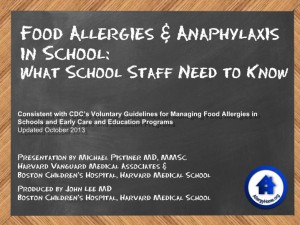 PREVIOUS MYTH:
'Nut Free' schools are safest
PREVIOUS MYTH:
'Nut Free' schools are safest
 NEXT MYTH:
Hand sanitizing gels eliminate food allergens
NEXT MYTH:
Hand sanitizing gels eliminate food allergens PREVIOUS MYTH:
'Nut Free' schools are safest
PREVIOUS MYTH:
'Nut Free' schools are safest
 NEXT MYTH:
Hand sanitizing gels eliminate food allergens
NEXT MYTH:
Hand sanitizing gels eliminate food allergens
 Staff Training: Food Allergies & Anaphylaxis in School – What School Staff Need to Know
Staff Training: Food Allergies & Anaphylaxis in School – What School Staff Need to Know
This 30 minute module is designed to assist the school nurse in staff training of management of life-threatening allergic reactions and increase food allergy awareness for all school staff including teachers, food service personnel, administrators, aides, specialists, coaches, bus drivers, custodians and others.
“High heat eliminates allergen.”
High heat and drying do not eliminate allergen.
Clean cooking surfaces, pots, pans, plates and utensils with soap and water; and surfaces with soap and water, commercial cleaners or commercial wipes. Make sure no chunks are left (even if dried out). This myth is especially important to know when preparing an item that is cooked on a common grill or in a common frialator.
Exposure to an allergen by cross contact is a common cause of allergic reactions. Cross contact of food allergen can occur from contact with surfaces, other foods, and with transfer of saliva. If a person is then exposed to these allergens, especially by mouth, it may be enough of an exposure to cause a serious allergic reaction.
Some recommendations vary depending on the allergen in question and the individual child. Assume that the student will need complete avoidance of allergen and potential cross-contact unless otherwise noted by school nurse or healthcare provider.
Avoid Allergen; Cross Contact With Food Allergens: One page supplemental handout to reinforce school staff cross-contact prevention and cleaning skills.
Living Confidently With Food Allergy: Cross-contact: Chapter from parent handbook that reviews cross-contact basics and tips to teach children.
All information contained on the Schools.AllergyHome.org website is intended for informational and educational purposes. The information provided on this website is not intended to be a replacement or substitute for professional medical advice. Any information that you have received from Schools.AllergyHome.org should be verified with your licensed health care provider. Furthermore, decisions regarding medical care should not be based solely upon the content of this website but made after discussions with your health care provider. Consumers should never disregard or delay seeking medical advice due to the content of this site.
Your use of this site does not create a patient-physician relationship between you and AllergyHome.org.
Medical information changes constantly. Therefore the information on this site or on the linked websites should not be considered current, complete or exhaustive, nor should you rely on such information to recommend a course of treatment for you or any other individual. Reliance on any information provided on this site or any linked websites is solely at your own risk.
Please note that AllergyHome is not affiliated with Boston Children’s Hospital